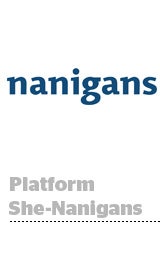 Changes are afoot at Nanigans, as the Facebook ad partner repositions to serve in-house marketers strictly on a software subscription basis. The company has stopped signing new managed services business and will focus on getting its self-serve platform into the hands of marketers in the ecommerce and app verticals.
Changes are afoot at Nanigans, as the Facebook ad partner repositions to serve in-house marketers strictly on a software subscription basis. The company has stopped signing new managed services business and will focus on getting its self-serve platform into the hands of marketers in the ecommerce and app verticals.
As part of this singular focus on self-serve, the Boston-based company is parting ways with its COO Marc Grabowski. Marketing SVP Dan Slagen has also left the building.
Reached by AdExchanger, both Grabowski and Nanigans CEO Ric Calvillo couched Grabowski’s exit in terms of “strategic differences” over the future of the company. The key difference appears to be that while Grabowski saw continued opportunity to scale managed services (read: insertion order-based) revenue, Calvillo thinks the company had to choose between a managed services and self-serve software model.
That means moving away from its reliance on Facebook inventory, where Nanigans is still 100% focused. Calvillo said the company will soon sign partner deals to support real-time bidded inventory off the Facebook platform.
The switch to SaaS has become a common refrain in ad technology circles, as a wide range of intermediaries ranging from Rocket Fuel to TellApart to SHIFT to MediaMath seek to de-emphasize managed services. Such transitions are often undertaken with valuations in mind, since startups with pure software licensing fees tend to command “exit” prices at three to five times what I/O-based businesses can command.
Nanigans is one of 13 companies designated by Facebook as “strategic Preferred Marketing Developers” (PMDs) based on their business alignment with Facebook and their ability to drive revenue to the platform. The company also is certified to participate in the Facebook Exchange (FBX) real-time bidding private exchange, although the usefulness of that badge is somewhat in doubt the longer FBX is locked out of Facebook’s all-important mobile channel.
Grabowski’s exit comes less than two years after he joined from a plum sales job at Yahoo. Reached by AdExchanger, he expressed faith in the company and its management. He remains a shareholder.
AdExchanger also spoke with Calvillo.
AdExchanger: What are you up to with the shift to SaaS?
RIC CALVILLO: We’re entirely Facebook today still. We’re working on some non-Facebook sources of inventory but heretofore we’ve been all Facebook and all of our revenue is purely software and services fees. We don’t mark up the media. All of our clients pay the publisher directly.
That transition was somewhat difficult in that certain types of clients wanted us to take the media. It’s usually agency and brand partners that for whatever reason didn’t want to pay Facebook directly. With agencies, sometimes they want longer credit terms and they wanted us to be accountable potentially for the liability of the media.
But even after getting out of the media reselling or distribution business, which is not unlike an ad network or media buying agency (most of our competitors among PMDs resell media, and most of the DSPs fulfill media) we still were conflicted with two different businesses in different markets. And I decided in Q1 that we needed to pick one to be successful. The two businesses are selling traffic for Facebook, and selling software to enable the client to do their own campaign management and optimization.
Are we doing campaign management as a managed service and selling traffic to the client? Or are we selling software the client uses and taking at least some responsibility for the performance of their campaigns.
Selling traffic would be an I/O-based business?
Right. We’ll try you for a quarter and if it performs, we’ll stay with you.
Business was great last year. But what percentage of it was clients buying traffic and what percentage was clients buying software? It’s not black and white. Some clients are using some of the software – say reporting and analytics – but not pushing ads.
For me, it is pretty binary. There’s a litmus test: Mr. Advertiser, are you taking some responsibility for the performance of the campaign? And better yet, are you willing to sign a one-year contract where you pay us for use of the software independently of how much you spend on ads and independently of the performance of the campaign?
And you’re starting this transition today?
We’re not taking any new managed services business, and we’re trying to transition all existing accounts to in-house management.
Is the Facebook platform in your future?
Our future is industry-focused. I’d like to consider us a vertically specific, more self-service version of the DSP. Where Turn and MediaMath and Invite [DoubleClick Bid Manager] are very horizontal and will sell to brands, agencies and performance advertisers, we want to focus on ecommerce and app developers and sell them a platform. And whatever sources of inventory are working with them, we want to support.
We’re committed to Facebook and RTB.
How do you get access to non-Facebook inventory?
We have several partnerships in the works, none to announce today.
What will you do with your managed services teams as you phase out that business?
A couple of our partners have already hired away some of our managed services people. A couple of them have left and started certified consultants for us, using our software specifically.
So we’re kind of like a MediaMath, with Kepler Group, but nothing as formal as what they did.
But the vast majority of good managed-services people we want to transfer to being platform account managers.
What’s the attraction of the SaaS model?
With SaaS, there’s no cost savings. It’s the same cost whether we run the campaign or whether we support the client running the campaign.
The attraction is a much more predictable and sticky business. Also, it’s hard to build the best platform when you’re trying to service customers.
The higher valuations for SaaS companies must also be attractive, right?
You’re right. I asked an investor recently what he thought the difference in valuation would be for a variable, campaign-driven percentage of spend type business vs. annual contract and the answer was 5x.
It may not be 5X, it may be 3X, but it’s in that range.
How many subscription-based direct advertiser clients do you have?
We have 15 subscriptions. The minority is annual contracts. The majority is platform, but it’s variable still – meaning monthly billing. Our goal is to move ASAP to the majority of our revenue being annual contract.
It’s a great litmus test. If you really want to build this competency in-house, then you should commit to a software platform.
How many total advertisers do you have on the platform?
One hundred-plus are active. Our software is currently driving over $350 million annualized spend. We’re pretty big on FBX. I think we’re in the top two or three.
FBX doesn’t seem like such the hot ticket lately, since it’s locked out of mobile. Is there still good spend running through it?
It’s good for ecommerce because ecommerce isn’t as mobile, but we wish that it were available with mobile.
What was behind COO Marc Grabowski’s departure?
This is the largest company I have run. Marc has (worked at) a much bigger organization at Yahoo. To steer the ship in a more focused direction, you have to make radical changes. He’s a great guy. If we were further along on the SaaS business – one or two years from now – he could really scale the business. He’s definitely a great scale guy.
So he wanted to make the business into a Rocket Fuel and you wanted to make it a Turn?
I want to make it a Marketo, not a Turn.
What else?
The biggest disruption happening in ad tech is not necessarily RTB but the direct-to-publisher client relationship that Facebook and Google have created to the tune of – we estimate – $20 billion. They’ve taken 20% of the online media spend and offered a Web-based platform that SMBs can come to directly, and of the remaining non-SMB enterprise, they’re going to push we estimate a third of them to manage in-house with no middle men – no media agency, no ad network, no DSP.
If you look at Facebook this year, they’re on a $10 billion revenue run rate in Q1. We think half of that is SMB and a third of the remaining half is in-house managed. We’re going after that third non-SMB, that $1.5 billion that is in–house managed for which we think they need a better platform than Power Editor.













